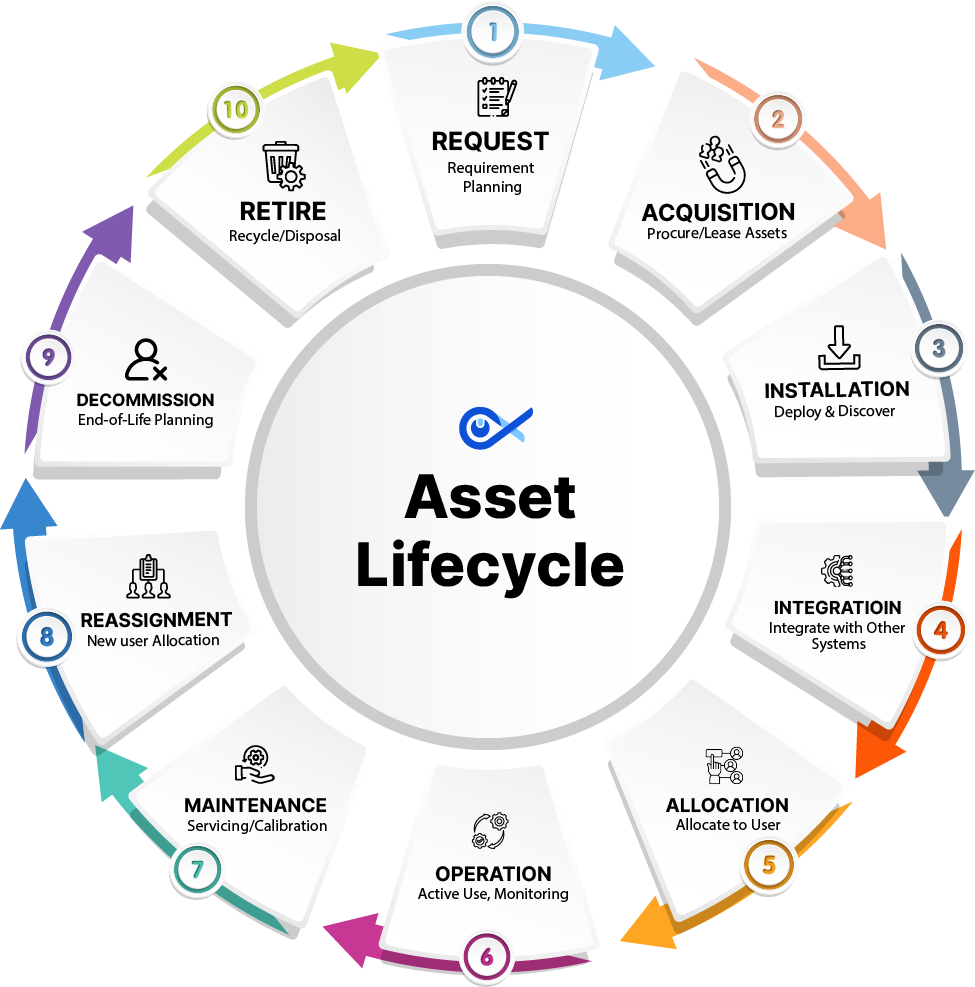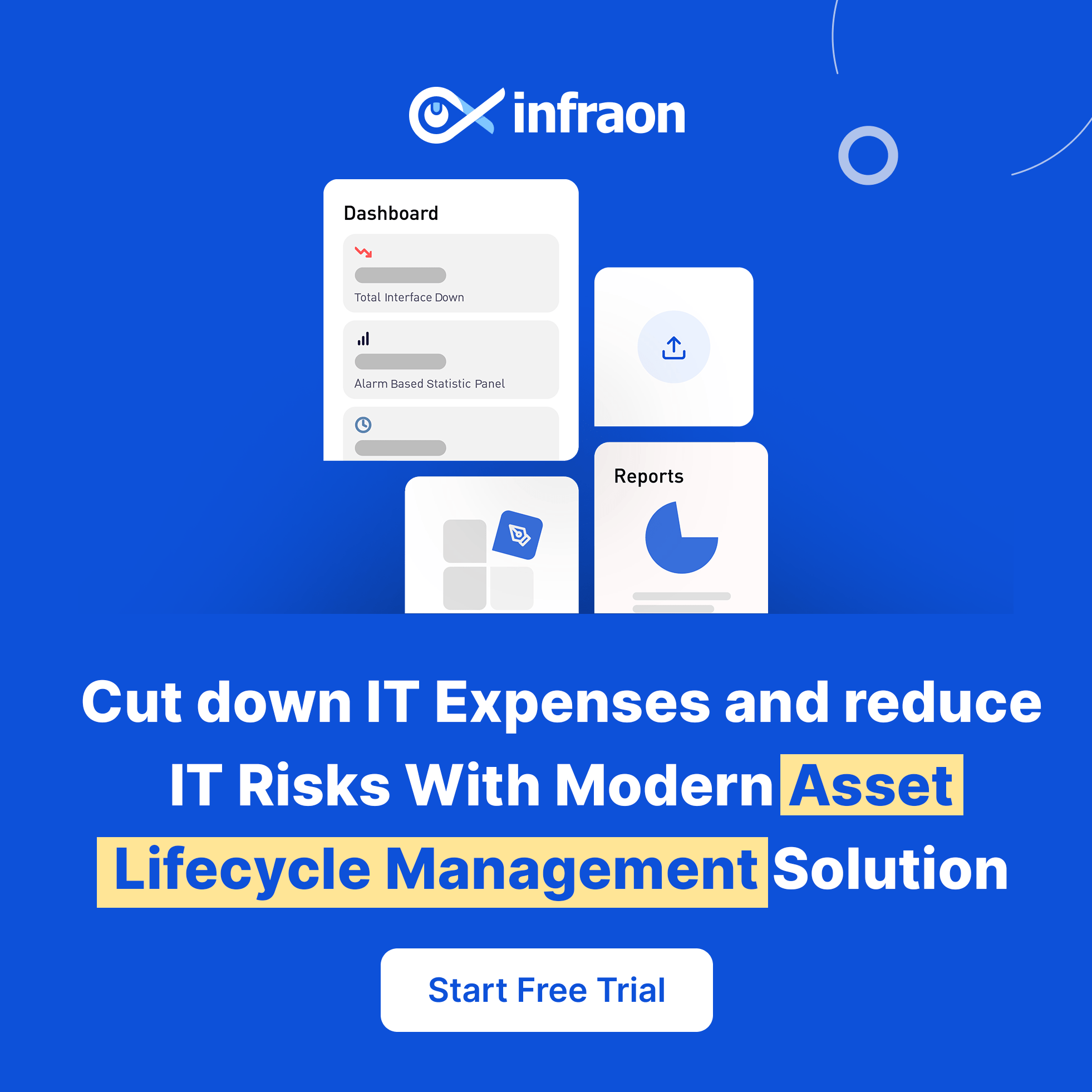The concept of asset lifecycle management (ALM) has been at the forefront of enterprise operations for many years, and its importance is likely to continue in the coming years. ALM plays a crucial role in helping businesses manage the acquisition, maintenance, and disposal of their assets and resources. Companies that effectively manage their asset lifecycle will benefit from improved operational efficiency, higher ROI, and a reduced risk of downtime.
This article provides a comprehensive guide for asset lifecycle management in 2023. We will look at the importance of ALM, the tools and technologies used, and the key benefits of efficient ALM. We will also discuss the best practices for successful asset lifecycle management and how to ensure your organization is prepared for future changes in the industry.
Related blog: The 6 Best IT Asset Control Software in 2023
Asset Lifecycle Management and Stages
Asset Lifecycle Management (ALM) is a strategic approach businesses use to manage their assets throughout their entire lifecycle. This process helps organizations optimize their assets’ value, minimize costs, and ensure that assets are used efficiently and effectively. It is essential for efficient operations and success in the business world. Asset management involves using a systematic process to manage assets from acquisition to disposal. This process is known as the asset management lifecycle. The asset management lifecycle comprises 10 stages: Request, Acquisition, Installation, Integration, Allocation, Operation, Maintenance, Reassignment, Decommition, and Retirement.

Request

The Request stage in asset lifecycle management involves initiating the asset management process by identifying and planning the specific requirements for acquiring an asset.
This phase encompasses understanding organizational objectives, conducting feasibility studies, defining asset specifications, estimating budgets, and articulating expected benefits. Collaboration among departments ensures a comprehensive understanding of the asset’s purpose, helping refine specifications, evaluate vendors, and create a proposal for approval.
Once reviewed and approved, the request becomes the basis for subsequent asset acquisition, installation, operation, and maintenance stages within the lifecycle management process.
Acquisition
The Acquisition stage within asset lifecycle management involves strategically procuring assets to meet specific organizational needs, encompassing planning, sourcing, negotiation, and obtaining assets aligned with budget constraints and operational requirements identified earlier in the Request phase.

This stage entails evaluating vendor options, negotiating pricing and terms, and finalizing agreements that ensure the selected assets provide desired features and quality while optimizing costs. Once agreements are reached, assets are procured, and processes such as purchase orders, logistics coordination, and quality checks are employed to integrate them into the organization.
Documentation of procurement details is crucial for tracking, managing warranties, and assessing vendor performance, making the Acquisition stage instrumental in acquiring assets that contribute to organizational efficiency and goals.
Installation
The Installation phase in asset lifecycle management is a pivotal step where assets are strategically deployed, discovering optimal locations for seamless integration.

This process entails meticulous coordination, encompassing physical installation, software setup, and configuration alignment.
Challenges are addressed through thorough testing, and comprehensive documentation captures procedures and configurations, serving as a valuable reference for maintenance and future upgrades.
This stage ensures assets effectively function within the operational context, harmonizing with the organization’s objectives and contributing to its overall success.
Integration
The Integration stage in asset lifecycle management is a crucial phase where assets are seamlessly aligned and integrated with existing systems and processes.

This involves meticulous planning, configuration, collaboration, and testing to ensure smooth collaboration and optimized functionality. Successful integration reduces redundancies, enhances efficiency, and unlocks the organization’s resources.
Documentation captures integration processes, serving as a valuable resource for troubleshooting and future decision-making. This stage is pivotal, orchestrating the fusion of assets to create a cohesive operational landscape.
Allocation

The Allocation stage in asset lifecycle management strategically distributes assets to users or departments, ensuring optimal utilization based on user needs and operational criteria.
This process prevents resource waste and improves efficiency, guided by clear guidelines and documented records. Effective communication and collaboration enhance allocation strategies, aligning asset usage with organizational goals for improved performance.
Operation
The Operation stage in asset lifecycle management involves the active use of assets within defined processes, coupled with continuous monitoring to assess performance, health, and utilization. During this phase, assets are aligned with their intended purpose, adhering to established operational procedures and performance benchmarks. Regular monitoring involves data collection, trend analysis, and insights generation to optimize asset functionality, identify potential issues, and proactively address deviations from expected outcomes.
Maintenance

The Maintenance phase in asset lifecycle management involves regular servicing, calibration, and upkeep to ensure optimal asset performance and longevity. This includes routine inspections, cleaning, lubrication, component replacements, and calibration to maintain measurement accuracy. These preventive measures, guided by manufacturer guidelines and industry practices, minimize breakdowns, enhance productivity, and reduce downtime. Documentation of maintenance activities is crucial for historical tracking, schedule optimization, and compliance, ensuring assets function reliably and efficiently over their lifecycle.
Related blog: Best Asset Maintenance Software Guide in 2023
Reassignment:
The Reassignment phase within asset lifecycle management involves strategically reallocating assets to new users or departments, ensuring efficient utilization and alignment with evolving organizational needs.

This process includes assessing the asset’s suitability for its new role, evaluating required modifications, and considering user requirements. By optimizing the asset’s value in its contemporary context, through adjustments and integrations, the allocation to new users occurs with effective communication and collaboration.
Clear guidelines and documentation streamline the process while contributing to cost-effectiveness by repurposing assets and enhancing operational efficiency, allowing organizations to adapt to changes and maximize asset value.
Decommission
The Decommission stage in asset lifecycle management is a critical phase where assets are systematically retired from active service, involving end-of-life planning for responsible disposal, recycling, or repurposing. This phase encompasses securely removing assets from operations, safeguarding sensitive data, and adhering to safety protocols during physical removal. Documentation of decommissioning activities supports compliance, audits, and responsible asset management.
Additionally, the Decommission stage provides insights into asset performance and impact, informing future decisions and demonstrating an organization’s commitment to environmental sustainability and ethical asset retirement.
Retire
The retirement phase in asset lifecycle management involves assessing assets for end-of-service life, leading to their responsible disposal or recycling. This phase evaluates factors like obsolescence and performance, identifying assets for retirement.

Disposal and recycling align with sustainability goals, adhering to environmental regulations and data security. Comprehensive documentation ensures compliance and the retirement phase is a learning opportunity for optimizing future asset management decisions. Organizations showcase their commitment to environmental sustainability and ethical asset management through responsible retirement practices.
By carefully managing each stage of the Asset Management Lifecycle, organizations can optimize asset performance, minimize operational risks and costs, and make informed decisions about asset investments throughout their lifecycle. Effective asset management leads to increased efficiency, better resource utilization, and improved overall business performance.
Importance of Asset Lifecycle Management
Asset lifecycle management is managing an asset throughout its entire life cycle, from acquisition to disposal. It involves tracking the asset’s performance, maintenance, repair, and replacement needs. Asset lifecycle management is essential for several reasons:
1. Cost control: Proper asset lifecycle management ensures that assets are maintained and repaired in a timely manner, minimizing downtime and reducing the need for expensive repairs or replacements.
2. Improved efficiency: By tracking the performance of assets over time, organizations can identify inefficiencies and implement improvements to increase productivity and reduce waste.
3. Compliance: Asset lifecycle management helps organizations comply with regulations and standards governing the use and disposal of assets.
4. Risk management: Effective asset lifecycle management can reduce the risk of accidents, breakdowns, and other problems that can cause harm to employees or damage to property.
5. Sustainability: Asset lifecycle management can help organizations reduce their environmental impact by ensuring that assets are used efficiently, maintained properly, and disposed of responsibly.
6. Planning and budgeting: By tracking the lifecycle of assets, organizations can plan for future replacements and budget accordingly, avoiding unexpected expenses and ensuring they have the resources they need to maintain their operations.
In short, asset lifecycle management is critical for ensuring organizations operate efficiently, comply with regulations, manage risks effectively, and plan for the future. By taking a proactive approach to asset management, organizations can benefit from minimizing costs, maximizing performance, and achieving their business goals.
Benefits of Asset Management
Here are some of the benefits of implementing Asset Lifecycle Management:
1. Cost Optimization:
Asset lifecycle management helps organizations optimize costs associated with their assets. By tracking and analyzing asset performance and maintenance data, organizations can identify cost-effective strategies for asset utilization, maintenance, and repairs. This leads to reduced operational expenses and downtime, ultimately improving the organization’s bottom line.
2. Improved Asset Performance:
Asset lifecycle management ensures that assets are regularly maintained, repaired, and upgraded as needed. By taking a proactive approach to asset management, organizations can enhance asset performance and reliability. Well-maintained assets operate efficiently, leading to increased productivity and smoother operations.
3. Enhanced Asset Utilization:
Through asset lifecycle management, organizations can closely monitor asset usage and performance data. This insight allows them to identify underutilized assets and redeploy them to areas where they are needed most. Better asset utilization leads to optimized resource allocation and reduced wastage, further improving operational efficiency.
4. Regulatory Compliance:
Asset lifecycle management facilitates compliance with relevant regulations and industry standards. Proper documentation and tracking of asset maintenance and disposal activities ensure that assets meet safety, environmental, and legal requirements throughout their lifecycle. This helps organizations avoid penalties and maintain a positive reputation
5. Strategic Planning:
Asset Lifecycle Management provides valuable data on asset lifecycles. With this information, organizations can plan for replacements and upgrades strategically and in a timely manner. By avoiding unexpected asset failures, organizations can ensure continuity in their operations and make efficient use of their resources.
6. Risk Management:
Asset lifecycle management enables organizations to regularly assess asset conditions and identify potential risks. Proactive maintenance and timely replacements reduce the likelihood of asset-related incidents that could lead to downtime, safety hazards, or financial losses. Effective risk management enhances overall operational reliability.
7. Increased Sustainability
Proper management of asset lifecycles promotes sustainable practices. Asset lifecycle management encourages responsible asset disposal, recycling, and reuse, reducing the environmental impact of asset management activities. This supports an organization’s commitment to environmental responsibility.
8. Better Financial Planning
Asset lifecycle management provides insights into asset depreciation, maintenance costs, and expected replacement or upgrade expenses. This information helps organizations plan and budget more effectively, ensuring they allocate resources appropriately and avoid unexpected financial burdens.
9. Improved Decision Making
Asset lifecycle management delivers comprehensive data and analytics on asset performance, usage, and costs. Armed with these insights, decision-makers can make informed choices regarding asset investments, maintenance strategies, and operational improvements. This leads to more effective and efficient asset management decisions.
10. Streamlined Documentation and Auditing
Asset lifecycle management ensures that all asset-related information, including purchase details, maintenance records, and disposal data, is well-documented and easily accessible. This streamlines auditing processes and supports compliance requirements, simplifying internal and external audits.
Overall, Asset Lifecycle Management can help organizations save costs, improve asset utilization, comply with regulations, make better decisions, and promote sustainability by adopting several best practices.

Best Practices of Asset Lifecycle Management
Asset lifecycle management (ALM) involves the planning, acquisition, operation, maintenance, and disposal of an asset. Here are some best practices for asset lifecycle management:
Create a comprehensive inventory.
The first step in asset lifecycle management is to create an extensive inventory of all the organization’s assets. It should include physical assets, software, and intellectual property.
Develop a lifecycle management plan.
Once the inventory is created, develop a lifecycle management plan that includes the expected lifespan of each asset, maintenance schedules, and end-of-life procedures.
Use asset-tracking tools.
Utilize asset tracking tools to keep track of all assets throughout their lifecycle. It can include barcodes, RFID tags, or identification methods.

Conduct regular maintenance.
Regular maintenance keeps assets functioning properly and extends their lifespan. Develop a maintenance schedule based on the expected lifespan of the asset and the manufacturer’s recommendations.
Train staff.
Ensure that staff is trained in the proper use and maintenance of assets. It can help prevent damage to assets and prolong their lifespan.
Monitor asset performance.
Monitor asset performance to identify potential issues before they become major problems. It can be done through regular inspections and analyzing data from asset monitoring tools.
Dispose of assets responsibly.
When an asset reaches the end of its useful life, dispose of it responsibly. This may involve recycling, selling, or donating the asset.
Continuously improve ALM processes.
Review and improve the ALM processes regularly to optimize asset usage, minimize downtime, and reduce costs.
By following these best practices, organizations can ensure that their assets are managed effectively throughout their lifecycle, resulting in improved efficiency, reduced downtime, and cost savings.
Tools and technologies used in ALM
The tools and technologies used in ALM vary depending on the type of asset being managed, but some common ones include:
Enterprise Resource Planning (ERP) Systems
ERP systems are used to manage asset lifecycle management’s financial and operational aspects. They provide a centralized platform for managing asset data, including asset identification, location, maintenance history, and financial data. ERP systems are particularly useful for managing assets with high monetary value, such as production equipment and vehicles.
Computerized Maintenance Management Systems (CMMS)
CMMS is software for managing asset maintenance activities. It provides a platform for tracking maintenance schedules, creating work orders, and documenting maintenance activities. CMMS is beneficial for managing assets that require regular maintenance, such as production equipment, vehicles, and buildings.
Internet of Things (IoT) Sensors
IoT sensors are used to collect real-time data on assets. They can be used to monitor asset performance, identify potential maintenance issues, and optimize asset utilization. IoT sensors are handy for managing assets with complex maintenance needs, such as HVAC systems and production equipment.
Geographic Information Systems (GIS)
GIS is software for managing spatial data. It can map asset locations, track asset movements, and analyze asset utilization. GIS is ideal for managing assets with a large geographical footprint, such as pipelines and transportation infrastructure.
Radio-Frequency Identification (RFID)
RFID is a technology that tracks assets using radio waves. It provides a platform for real-time asset tracking and can be used to automate inventory management processes. RFID is effective for managing assets with high mobility, such as vehicles and mobile equipment.
Predictive Analytics

Predictive analytics is a technology used to analyze asset data and predict future maintenance needs. It provides a platform for proactive maintenance management, reducing downtime, and extending asset lifetimes. Predictive analytics helps manage assets with complex maintenance needs, such as production equipment and vehicles.
Overall, the tools and technologies used in ALM are designed to help organizations manage their assets more efficiently, reducing costs and maximizing asset utilization.
Key Metrics of IT Asset Lifecycle Management
IT asset lifecycle management is a vital aspect of every organization. By optimizing asset performance and reliability, you will find it easy to offer your business the desired growth and generate excellent revenue. So, it is important to acquire an understanding of the asset lifecycle and look for opportunities to maximize the value of your assets. Here are going to talk to you about some of the key metrics for measuring the success of different IT asset lifecycle management programs.
Stale Assets
Stale assets are the number of assets waiting to be updated. This includes both hardware and software. This metric reflects how efficiently your team is updating the available resources. It signifies how protected you are from different cybersecurity threats. It also allows you to prioritize pending updates so that your software and hardware devices remain compliant.
Asset Utilization
It is also important for your company to have a clear idea of how much of its software and hardware assets are used effectively. This metric will provide you with an insight into the IT needs of your business. You will also get to know the effectiveness of your budget. You can use this data to reduce your IT costs and allocate resources in a better way. You can also use IT asset lifecycle management software to determine asset utilization.
Lifecycle Management
Managing the life cycle of your assets is an important part of IT asset management. By carefully monitoring every stage of the asset life cycle, you can plan for future investments. You should also keep track of the assets used frequently and the assets reaching their retirement. This will help you to ensure that your business experiences minimum downtime. You can also plan for asset maintenance.
Total cost of ownership (TCO)
Total cost of ownership or TCO refers to the total cost associated with owning and managing an asset throughout its entire lifecycle. This involves the initial cost of purchasing the asset along with the cost of maintenance, upgrade, and disposal. By calculating the total cost of ownership, businesses will be able to make well-informed decisions about asset acquisition. You can also rely on hardware asset management to find the total cost of ownership of hardware devices.

Asset lifespan
Asset lifespan refers to the complete period during which an asset remains functional before it is required to be replaced. This is a crucial metric for asset lifecycle management. It allows your company to plan for asset replacement and maintenance and identify various trends and patterns that may affect the longevity of your asset.
Related Blog: Asset Lifecycle – Definition and Key Stages in 2023
Final Note
Asset Lifecycle Management (ALM) is a comprehensive approach to managing an asset from its initial acquisition to disposal. ALM provides numerous benefits to organizations, including increased asset utilization, improved asset performance, reduced downtime, and better cost management.
Organizations can make informed decisions about asset maintenance, upgrades, and replacement by effectively managing assets throughout their lifecycle. It ensures that assets remain reliable and efficient, reducing the risk of unexpected failures or downtime. Additionally, ALM can improve financial performance by reducing maintenance and repair costs, extending asset lifetimes, and optimizing asset utilization.
Furthermore, ALM enables organizations to meet regulatory requirements, such as environmental and safety regulations, by ensuring that assets are maintained and disposed of properly. Organizations can identify opportunities to improve operational efficiency and reduce waste by tracking and monitoring asset performance and utilization.
Therefore, Asset Lifecycle Management is a critical tool for organizations looking to optimize asset performance, reduce costs, and meet regulatory requirements. By adopting a comprehensive approach to managing assets, you can improve your organization’s operational efficiency, reduce risk, and improve financial performance.

























